Bird tracking
Phil Atkinson explains the technology behind tracking birds.
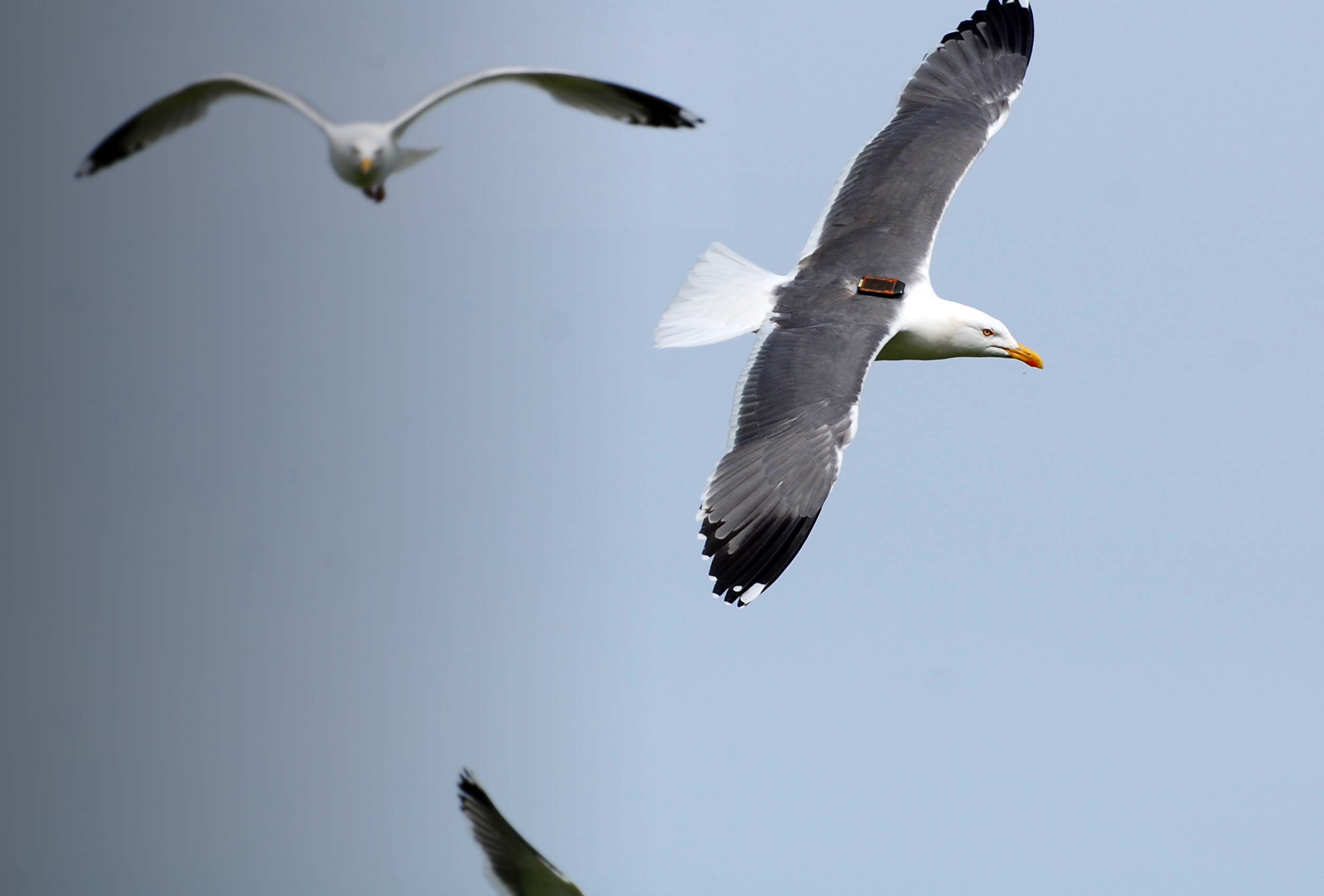
Related topics
From satellite tags the size (and shape!) of a brick to 0.3 g geolocators, wildlife tracking devices have come a long way over the past 30 years.

In 1989, albatrosses were the first birds remotely tracked using satellites and they revolutionised our understanding of seabird movements at sea, showing the vast circumpolar journeys these magnificent birds take on days' long foraging trips to feed their single chick. Since then, there has been an explosion in the number of studies that track the movements and migration of a multitude of species.
Researchers and conservationists have used tracking for many different reasons, including, for example, unravelling the migration of some of our long-distance migrants, understanding how birds exploit food resources in terrestrial or marine environments, and using tags to combat wildlife crime.
Each species has a story to tell and the old adage of ‘fit a tag to a bird and you will find out something new’ is true – after 30 years, extraordinary discoveries are still being made.
Tag manufacturers are continuously pushed by their users to make tags smaller, more efficient and smarter, spawning an industry in devising solutions. Some recycle old technology in a new way, and others devise completely new ways of being able to pinpoint where an animal is.
The technologies
Geolocators
Geolocators are now available at less than a third of a gram and are among the smallest and lightest tracking devices on the market. Made up of very simple technology, they comprise a battery, light sensor, clock and a memory chip. They record light levels every few minutes and by plotting these against time, the times of local dawn and dusk can be estimated.
Once these twilight events have been calibrated (i.e. related to an astronomical event, such as the position of the sun relative to the horizon), day length can be used to estimate latitude. The midpoint between dawn and dusk gives solar midday, which varies by 1 hour for every 15 degrees of longitude. By combining the longitude and latitude, it then provides an estimate of its location.
Although accuracy is dependent on the extent to which shading by foliage, clouds and feathers is accounted for, and rarely exceeds 150 km, these tags have uncovered the migrations of long-distance migrants such as Swift, Nightingale, Wood Warbler and Spotted Flycatcher. Although error in the position is usually unknown and may be relatively large, the temporal precision of these tags is very good.
For birds starting off on a long journey it may be possible to pinpoint the exact day of departure. Geolocators have also given us unexpected benefits. Tagged birds can show very large fluctuations in light and dark during the day, indicating a change in behaviour – for example, incubating eggs.
When the female leaves the nest, she is suddenly exposed to a spike in light which is logged on the tag. In one case, shorebirds caught by researchers in Australia have revealed that breeding success can be inferred in these birds, which breed in the most remote areas of the globe, all by the changing patterns of light and dark as they get on and off the nest.
PTTs (Argos Platform Transmitter Terminals)
Argos is a network of satellites devoted to environmental studies and at any one time, over 20,000 devices are actively sending data through the network.
The smallest tags are ‘Doppler PTTs’ – if a satellite comes into view whilst these tags are transmitting, the satellite will ‘hear’ the signal at a slightly different pitch as it passes towards and away from the tag (the ‘Doppler effect’), much as the sound of a fast train passing you on a platform changes as it moves towards and then away from you.
These signals are analysed by the Argos ground stations and they then calculate a position for the tag which, depending on how directly the satellite passes overhead, may be accurate to up about 600 m, although often much less. The advantages of this method are the low transmitter power consumption and instant location opportunities during satellite passes.
... the old adage of ‘fit a tag to a bird and you will find out something new’ is true – after 30 years, extraordinary discoveries are still being made.
GPS
When tracking animals, users ideally want highly accurate positions. GPS is the best known solution to this issue and was developed in the USA, but other systems developed by Russia (GLONASS), China (BeiDou) and Europe (Galileo) are broadly similar.
This method gives high precision fixes which are accurate down to a few metres or less. GPS is the most widely used and can be found in devices weighing about 1 g upwards. The smallest devices only store the data and do not transmit them (so-called archival tags) so the bird needs to be re-caught to download the data.
The mass production and miniaturisation of GPS technology has brought the cost down allowing large samples of birds to be tracked. One notable new development is Fastloc®, developed by Wildtrack Telemetry Systems Ltd.
This very low-power system gives near GPS accuracy (20–75 m) by taking a quick snapshot of the radio signals produced by overhead GPS satellites. Processing and storing these signals takes just 12 seconds and, where extreme accuracy is not necessary, this is a good alternative to standard GPS.
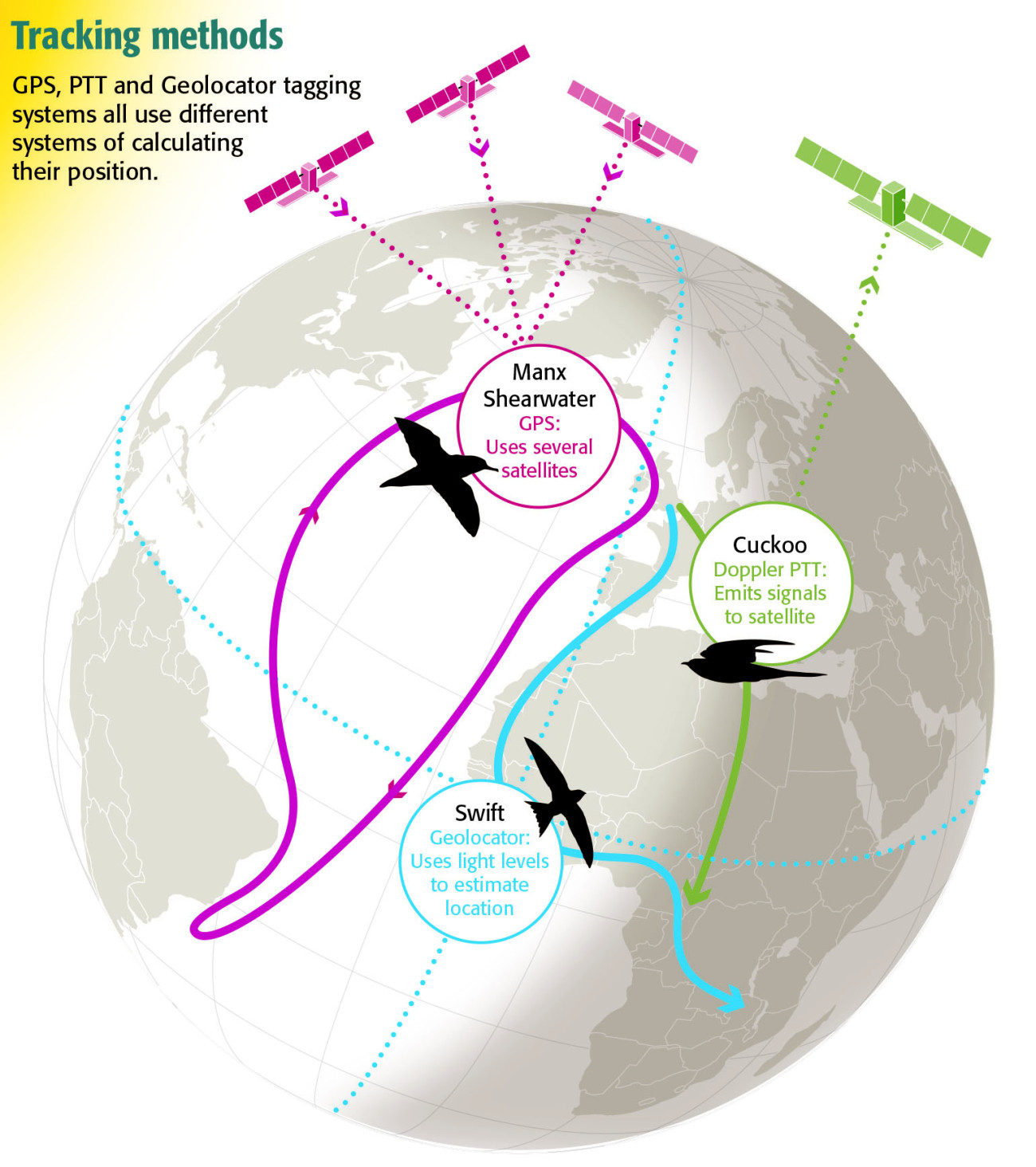
Accessing the data
Downloading data remotely is a huge advantage and makes tracking studies much easier, but comes with extra weight and power requirements for the tag. Devices now use various technologies, including the mobile phone network, satellites (e.g. ARGOS or telecommunications satellites such as Iridium or Inmarsat), or VHF radio to download to a base station that collects the data as a bird passes it.
Each system has its pros and cons in terms of weight, power requirements and cost. Ironically, one of the most power-hungry systems is not one that transmits to satellites orbiting the earth hundreds of kilometres away, but the system that uses the terrestrial mobile phone network.
With peak currents of around one Amp (other transmission methods may be less than a tenth of that), it needs a high energy density battery, such as a Lithium battery. It is not yet possible for the really small devices (less than 12 g) to use this technology because of the battery issue, but mobile phone transmission is far cheaper per Mb of data compared to other systems so is the system of choice for many studies.

Bringing the tracks to life
Understanding that a bird moves from A to B to C is great, but what is it doing there? This question can often be answered using additional sensors. Small cameras fitted to birds give an indication as to what birds are doing over a short period of time, but are not a long-term solution. Among the most used devices are the accelerometer and the gyroscope.
Three-dimensional accelerometers detect acceleration and deceleration, as well as the device's orientation, whilst the gyroscope measures rotation. Some devices include a magnetometer, which detects the earth’s magnetic field and is in effect an electronic compass. This is important in migration studies as it allows us to answer key questions, such as how birds navigate during their migration and how they mitigate adverse weather conditions.
These are just a few of the sensors being put in tags, and they give us a wealth of data on how the bird is behaving. Couple this with the vast array of remote-sensed data from government agencies such as NASA and it is possible to build up a year-round understanding of how individuals interact with their environment, even when animals might migrate to extremely remote areas.
Technology continues apace and virtual reality is fast becoming a mainstream product. We are starting to see 3D visualisations of bird tracks showing the landscape, as well as other tracked individuals, from the point of view of an individual bird.
One representation at the 2017 Bio-Logging Symposium allowed the user to be a White Stork spiralling up in the thermals. From its perspective, you could observe the surroundings and other tracked storks! These new technologies, evolving alongside tracking technology, will change the way we view data.
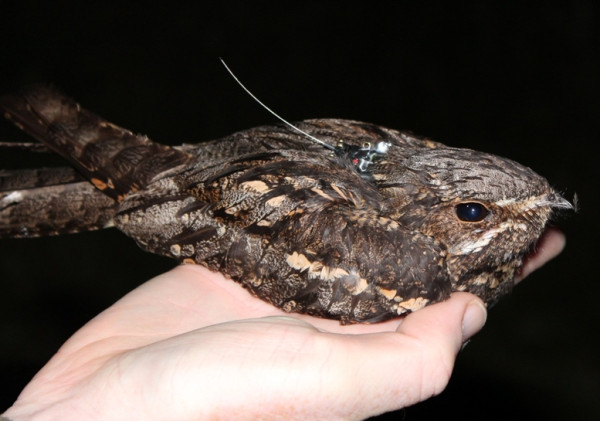
The tracking community
The growth in tracking studies has been extraordinary. In 2012, Movebank was launched to help researchers manage, share, analyse and archive their animal movement data. Hosted by the Max Planck Institute for Ornithology and with more than 17,000 subscribers, Movebank has built a real community of users, be they individual researchers, universities or government agencies.
It allows for easy sharing of tracking data with other users and the public. In January 2018, it held 657 million locations, 1.1 billion non-location events (e.g. accelerometer and other sensor data), 4,182 studies of 756 taxa and over 5,000 data owners. Movebank also allows for seamless integration with large-scale remote-sensed data sets, and is an extremely valuable tool for the analysis of movement data on a global scale.
The 1714 Longitude Act
In 1714, Parliament passed the Longitude Act. The Act lay down the challenge to invent a device that could ensure ships could correctly position themselves. European nations all raced to solve this problem.
The sum of £20,000 was offered to anyone who could solve the longitude problem. It was John Harrison, a joiner and clockmaker, who came up with a solution. By knowing the time at a reference point and the local time from the Sun, it was then possible to determine longitude.
The problem was that clocks were not accurate enough and drifted from the accurate time. Over a period of 45 years, John Harrison came closest to achieving the prize by developing several clocks which culminated in his marine chronometer ‘H4’. This technology which took 45 years to perfect is now available in a package weighing less than a third of a gram!
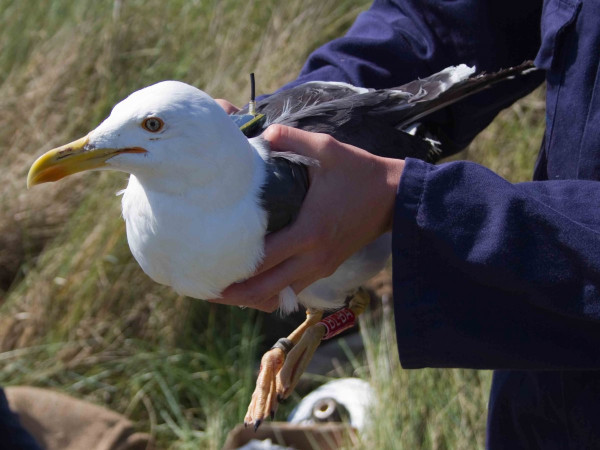
The future
The beauty (and trouble!) with tracking is that any predictions made here will be out of date in a very short period of time. The demand for additional sensors is increasing and new analytical techniques will be required to deal with the vast amount of data that tracking studies generate.
One example of a promising new innovation comes from the seabird community. Seabirds are at threat from legal and illegal long-line fishing. To try and understand how much time juvenile Wandering Albatrosses spent foraging behind fishing vessels where they might be at risk, researchers fitted them with radar sensors so they could determine where and when they interacted with fishing boats.
One added benefit of this was that the radar-sensing tags turned the bird into an unofficial monitor of fishing patterns and could identify fishing vessels that were acting illegally!
Energy issues
However, one of the major issues with tags remains the battery. It is the most vulnerable part of each device and, as long as the rest of the tag is assembled correctly, it is almost always the reason why tags eventually fail. Lithium batteries are ideal as they pack in a lot of energy for their size, but these rechargeable batteries have a finite lifespan and are limited to a certain number of charges and discharges.
They are also quite vulnerable to extreme temperatures and so may not last much beyond two to three years for larger batteries, or less for smaller ones. Battery technology and innovation is moving forward, but not at the pace of other innovations. Graphene-based batteries are on the horizon and potentially could increase the lifespan.
If a perfect battery can be developed that can be charged and discharged continuously, the sky’s the limit! In the meantime, tag manufacturers are always looking at ways to minimise energy use and maximise efficiency when the tags operate.
Going into outer space
New ways of transmitting the data are also on the horizon. The Icarus project (International Cooperation for Animal Research Using Space) is the first satellite communication system that is dedicated to animal tracking. Developed by a German-Russian consortium, and led by Professor Martin Wikelski at the Max Planck Institute, this is a very exciting development.
An antenna attached to the International Space Station will pick up signals of tags from Earth and transmit them back to the users via Movebank. Together with further miniaturisation of electronics, even lighter devices using satellites may be possible in future.
In the terrestrial sphere new possibilities are also opening up. Long-range wireless technologies driven by the Internet of Things (internet-connected devices) are allowing low-power data transmission over longer distances. Mobile phone technology also continues to move forward.
The upcoming 5G network has efficiency and low power consumption as part of its core values, making it an exciting new technology for tracking. As with anything electronic, future tracking technology will inevitably be lighter, more efficient and cheaper, and new low-power satellite data communication systems are on the horizon.
However, the real innovations will be driven by the community of users. A multitude of sensors are already integrated into some tags and the users can identify different behaviours based on the data. Moving forward, smart tags will be able to process this information on-board and react accordingly. This will surely lead to new and innovative ways to track birds and continue the revolution in the way we study their behaviour.
- Learn more about our Spotted Flycatcher Appeal, raising funds to undertake new tracking work on this declining species.
Cuckoo Tracking Project
Follow our groundbreaking project and support this important work by sponsoring a Cuckoo.


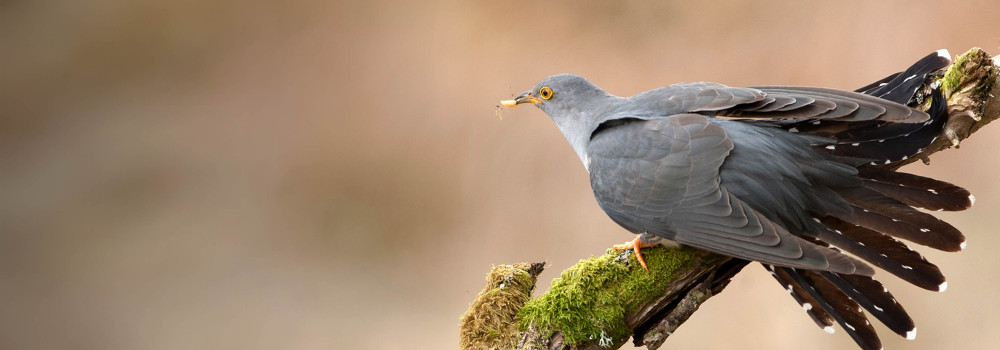
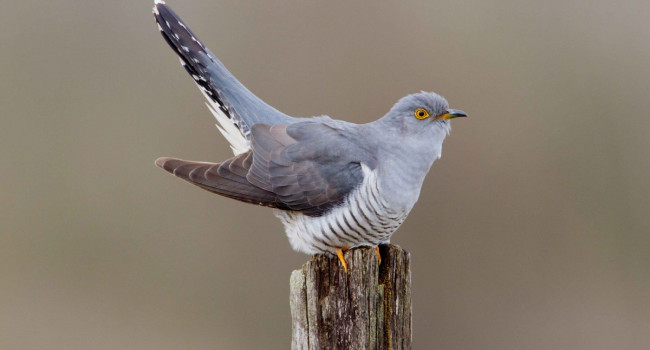
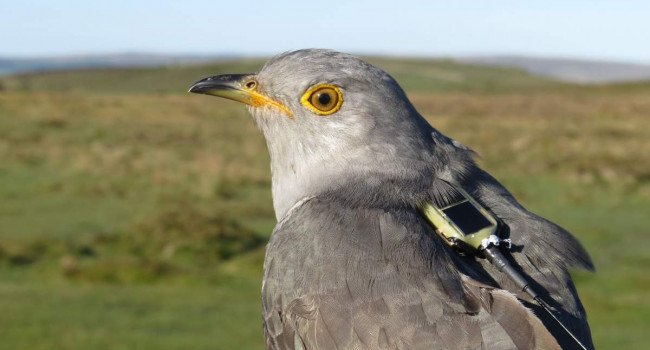

Share this page